Yoga as An Alternative to Prescription Drugs
[post-img]We, as a society, have figured out that our biology can be described by the various and complex chemical reactions happening behind the scenes. Regulating that biology, therefore, must only be a matter of manipulating – on the molecular level – the rate and composition of said reactions. Easy as pie, right?
But this isn’t necessarily so. The relationship between our bodies and the molecules that govern them is a two-way street; chemicals can have an effect on us, and we can have an effect on our chemicals. In a study on depression conducted in 2005, psychologists divided their subjects into two groups. One group was treated with meds designed to increase a deficient neurochemical, the other was treated only with group therapy. Both groups returned for evaluation and it was discovered that there was no neurochemical difference between them. Through therapy, the second group was able to regulate their own biochemical concentrations. Score one for alternative medicine.
[tip-fact]There has been some precedent established that prescriptions aren’t the only way to cure what ails us. But psychotherapy probably won’t help your heart disease or your diabetes. Luckily, however, there’s still another option: Yoga.
The National Center for Complementary and Alternative Medicine (NCAM) promotes integrative medicine – the combination of conventional medication with alternative medicine. One of the most popular of these alternative therapies is yoga, which is recently being extensively studied as a supplement to prescription medication. And so far it’s working.
Yoga is all about health management. Poses reach deep into the body to stimulate and massage various internal organs, biological systems, muscle bundles, and nerve groups. Yoga helps to keep your body running smoothly and efficiently. Deliberate, calm yoga practice helps remove tensions, relax the mind and improve vitality, thereby acting as a complete custodial service for all biological chemical systems. Regular practice not only contributes to a general healthy balance, but to a certain extent can even correct irregularities in our biological systems.
[b-quote] the nutrients and supplements it receives regularly. Practicing yoga in concert with prescription medication can boost a drug’s efficiency, thereby allowing for the required dosage to be cut down.
Moreover, using yoga for therapeutic means has one benefit not shared by more traditional western styles of healing. Pills, surgery, and even acupuncture (admittedly not a western tradition) are all passive forms of healing; the patient doesn’t take an active role in the process. They are simply present. Drugs and procedures are administered to the patient. And the patient – along with the associated condition – is left to respond to said treatment. Practicing yoga, however, requires the individual to take a conscious, active role in their own healing by becoming more invested in the curative process.
Being mentally and emotionally involved with one’s own healing is as crucial to the healing process as the treatment itself. If the placebo effect is any indication, our brains have an incredible impact on our biology. Making an effort, and consciously becoming actively involved in your own healing process could make the all the difference. The simple act of focusing on curing yourself can have a significant impact on healing.
Now none of this may be news, exactly, but it definitely provides good reason to seriously re-examine the pill bottles in your medicine cabinet. Sure, taking a few capsules with a swig of water is easier than dedicating a couple of evenings per week to diligently practice yoga, but prescriptions have their drawbacks too. Keeping prescriptions filled is not only a costly endeavor, but the regular consumption of some of these chemicals can often have surprising, unpleasant, and far-reaching consequences. For example, it’s an acknowledged fact that conventional pain management medication, if not managed correctly, can lead to addictions.
Alternative therapy can often assist individuals in reducing their discomfort without relying solely on conventional medication. It therefore seems advisable to keep prescriptions to a minimum and explore the possibilities of using alternative therapy – such as yoga – as a way to manage your own healing process.
For more information on the positive impact yoga can have on helping to heal illnesses and maintain health, check out this related article: Hawaii Health Guide: The Science of Yoga




